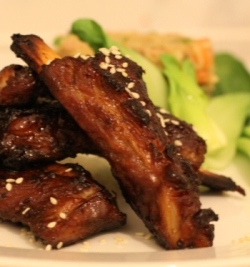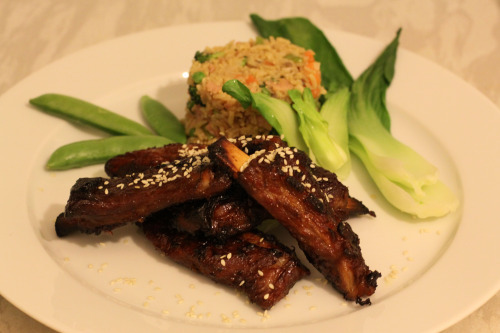Hugh Fearnley-Whittingstall’s Sticky apple balsamic spare ribs... sort of
 Wednesday, March 9, 2011 at 10:29PM
Wednesday, March 9, 2011 at 10:29PM Sort of?
I say ‘sort of’ because when you read the name of a dish in the title of a post, you probably expect the named ingredients to be central to it. I am sure Hugh Fearnley-Whittingstall would argue that they are, but I do not have apple balsamic to hand in my cupboard. Indeed I have never in my life come across it. I imagine most people are in the same position...
Imagined.
Actually a quick search on the internet suggests that I have been living a somewhat sheltered existence. The fact that I have never seen apple balsamic in any supermarket does not mean it is not widespread and abundant. Those two words produced no fewer than 1,200,000 results on Google. In fact, I could quite easily have purchased it online a few days earlier had I done this simple search then not now, post-making, cooking, eating.
 A friend from work suggested this as a recipe to try out for my blog. When I asked her where she had found apple balsamic she said she hadn’t had any either; it had worked perfectly well with balsamic balsamic. I decided to mix it up a bit and do 1/3 apple cider vinegar and 2/3 balsamic. Next time I might mix things up a bit more and try rice wine vinegar instead of balsamic and hoisin sauce instead of plum jelly. Maybe some Chinese five-spice too.
A friend from work suggested this as a recipe to try out for my blog. When I asked her where she had found apple balsamic she said she hadn’t had any either; it had worked perfectly well with balsamic balsamic. I decided to mix it up a bit and do 1/3 apple cider vinegar and 2/3 balsamic. Next time I might mix things up a bit more and try rice wine vinegar instead of balsamic and hoisin sauce instead of plum jelly. Maybe some Chinese five-spice too.
My colleague was particularly taken with the way that the fat melted away, the roasting juices with the marinade coating the meat in a delightfully sticky, finger licking sauce. Sadly, I didn’t quite manage to achieve this. I think there were several reasons for this, perhaps most significant was the fact that I didn’t use whole racks of ribs. This meant that the ribs cooked more quickly and I should have adjusted the cooking time accordingly (I only thought of this in retrospect). Had I been paying closer attention, I would have taken them out before the sauce dried up, while they were still ‘glossy’ and ‘coated in the caramelised sauce’.
Anyway, as you can see, all these issues can be remedied; it was just my poor judgement that was to blame. The recipe below is as per the original, you might be a better judge.
Serves four to six.
Ingredients
1.5kg free-range pork ribs (2 racks)
For the marinade
4 tbsp redcurrant, plum, crab apple or other fruit jelly
3 tbsp apple balsamic vinegar
2 tbsp light muscovado sugar
3 garlic cloves, crushed to a paste
1 tbsp finely grated fresh ginger
½-1 medium-hot red chilli, finely chopped, or ½ tsp dried chilli flakes
2 tbsp soy sauce
Steamed rice and wilted greens, to serve
Method
Whisk together all the marinade ingredients. Put the ribs in a large, ovenproof dish, pour the marinade over and, using your hands, turn the ribs around in it so they're all well coated. Cover and leave to marinate in a cool place for at least an hour, several hours if possible, turning them from time to time.
Heat the oven to 170C/335F/gas mark 3. Turn the ribs in their marinade one final time, cover the dish with foil and bake for 45 minutes. Raise the temperature to 190C/375F/gas mark 5.
Remove the foil and turn the ribs again, basting them with the sauce. Return the uncovered dish to the oven and cook for 35-45 minutes longer, turning and basting the ribs two or three more times, until they are glossy and dark and coated in the caramelised sauce.
Lift the ribs on to a serving plate and spoon any remaining sauce over them. Leave until they are cool enough to pick up with your fingers, then tuck in. Serve with steamed rice and wilted greens.


Reader Comments (2)
YUM!!!!!!!!!
this does sound finger licking good!
what if you make it again...for me?!!!!
What if you come to England especially? :)